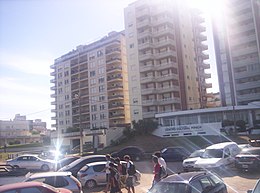Villa Gesell
| Villa Gesell | |
|---|---|
 |
|
| Location in Argentina | |
| Coordinates: 37°15′S 56°55′W / 37.250°S 56.917°WCoordinates: 37°15′S 56°55′W / 37.250°S 56.917°W | |
| Country |
|
| Province |
|
| Partido | Villa Gesell |
| Founded | 1931 |
| Government | |
| • Gustavo Barrera | Mayor (Front for Victory) |
| Elevation | 1 m (3 ft) |
| Population (2001 census [INDEC]) | |
| • Total | 23,257 |
| CPA Base | B 7165 |
| Area code(s) | +54 2255 |
Villa Gesell is a seaside village in Villa Gesell Partido, Buenos Aires Province, Argentina. It was founded in 1931, afforestating a dune field. The growth of the city allowed it to annex the nearby cities of Mar de las Pampas, Las Gaviotas and Mar Azul.
The town is named after Carlos Idaho Gesell, the son of German economist Silvio Gesell. Carlos Gesell bought wood at Tigre for his business, and wanted to plant pines somewhere near Mar del Plata to reduce costs. Gesell was not planning to build a town at that point. Héctor Guerrero told him of 16.48 km2 (6.36 sq mi) of sand dunes on sale for 28,000 pesos, and Gesell bought them in 1931 when he checked for the existence of groundwater in the area. The coastline was 10 km (6.21 mi) long. He immediately began to forest the area, and built a house for himself in 1932. This house is now a municipal museum.
The forestation work did not proceed as expected: the strong saline winds moved the sand and harmed the plants, exposing and drying their roots. Gesell hired German agronomist Carlos Bodesheim in 1934, who could not find a solution. He then implemented two new ideas. First, he planted a high number of beneficial weeds, capable of surviving in the dunes, in order to anchor the sand in place. He planted trees with tubed roots, so that the roots sought water deeper in the ground and the wind could not tear them. Losses were still high, but decreasing. In 1938 he learned about the Australian Acacia longifolia, which was well adapted to the sand and the saline winds, and increased the ratio of nitrogen fixation. The Acacia was a success, and he arranged the plants so that the Acacias protected the pines from the wind.
Carlos Gesell lived permanently in the area from 1937 on. He began to run out of money in 1940, so he built a small timeshare named "La Golondrina" (Spanish: The swallow). The first tourists were the Starks. Mr. Stark was manager of the local branch of the Siemens corporation. The Starks promoted the town back in Buenos Aires, and more tourist accommodations were built. The town was linked to Provincial Route 11 in 1943.
...
Wikipedia

